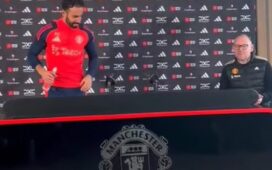West Ham’s image of themselves is not matched by the view from outside. A pragmatist such as Sam Allardyce could not connect with the club even when he managed them. The demand for entertainment infuriated him and he hated the West Ham way, regarding it with ill-disguised contempt.
The concept, loosely rooted in an insistence that “we play on the floor”, seems indulgent to outsiders. Alex Ferguson touched on the subject in his second autobiography, pleading with someone to define it for him. The response tends to be vague: good football. To Allardyce, it was a “millstone around the club’s neck”. It is wrapped up in identity, linked to the academy of football romanticism, and has become part of an unproductive culture war at the London Stadium.
It informs the debate around the club’s recent managers. Whereas Allardyce was disliked despite performing solidly, Slaven Bilic was accepted as he was a former player who built everything around Dimitri Payet’s individual brilliance. The appointment of the expensive Manuel Pellegrini was an apparent sign of ambition, but the return of the supposedly dour David Moyes in 2019 led to an outcry.
The Scot, who has lifted West Ham to fifth in the Premier League going into this weekend, has created a far more enterprising team than Pellegrini. Although he works for an unpopular board, he has kept the peace and introduced humility. There is no complacency with Moyes, who once admitted that when he managed Everton he thought West Ham were soft. He understands why the club underachieve, pointing to a chronic lack of patience, and has set about building a resilient, fit and efficient side. An identity has developed and, instead of focusing on fancy, fragile football, there is a different element to the West Ham way: set-piece prowess.

It is easy to be sniffy about that but not enough respect is paid to them. West Ham, who host fourth-placed< Liverpool on Sunday, are certainly benefiting from attention to detail. They have scored 11 goals from set pieces this season – Liverpool have managed 12 – and have conceded twice, the best record in the league. The solidity is a sign of robustness. A sign, as Angelo Ogbonna says, that “you can feel the seriousness around us”.
The Italian has been outstanding in defence with Craig Dawson, an astute loan signing. Both centre-backs are a threat in the air. Ogbonna scored important goals in wins over Aston Villa and Leeds; Dawson has charged from deep to attack inswinging crosses from Jarrod Bowen in victories over Stockport and Crystal Palace.
“We’ve got people who can head the ball,” Moyes says. “I have to give a lot of credit to Paul Nevin, Kevin Nolan, who are on my staff, who work hard in making sure we get the deliveries right and that we’re attacking all the right areas to try and score.”
That said, West Ham are not one-dimensional. In open play they are enjoyably direct, moving the ball forward quickly and attacking down the wings. Vladimir Coufal is buccaneering at right-back and his fellow Czech Tomas Soucek is a rampaging wrecking ball of a midfielder. Soucek’s goals have eased the burden on Michail Antonio, a handful up front, and the slowly improving Saïd Benrahma offers a dash of unpredictability.
At the same time, though, dead balls can be key. “I want to score open play goals but quite often the games in the Premier League can be so tight that a goal from a set piece can make such a difference,” Moyes said.
In the 4-0 win over Wolves in September, they broke the deadlock when Pablo Fornals played a quick free-kick to set up Bowen. The third goal arrived when an outswinging cross to the near post from the left-footed Aaron Cresswell, whose deliveries have been superb, was met by Soucek, whose glance went in off Raúl Jiménez.
Soucek, West Ham’s leading scorer with seven, is a nightmare to mark. Against Leeds he waited at the far post and towered over a defender. Against Brighton he rumbled in late to equalise. In Tuesday’s win at Palace, he crowded the six-yard box with Antonio and controlled Cresswell’s deep free-kick before volleying home.

Variety keeps opponents guessing. When West Ham took the lead against Manchester United last month, Cresswell sent a flatter delivery to the near post. Declan Rice flicked it on and Soucek ran to the far post to score.
The movement in the box is sharp and there was evidence of Nolan’s influence in Ogbonna’s goal against Villa. Antonio blocked Emi Martínez, preventing the goalkeeper from leaving his line. “Kevin was someone who had a knack of finding a way to get a bit of space in the box and become a pest,” Moyes said, praising the hard work behind the scenes.
“Everyone is on the team because they want to do something for the club,” Ogbonna says.
The Fiver: sign up and get our daily football email
West Ham have seen false dawns in the past. Under Bilic they fell apart when Payet left but Moyes is building carefully, guarding against the possibility of losing Rice. He is using a tight budget wisely and hopes to revive Jesse Lingard’s career after signing the United midfielder on loan.
The idea is to promise less and deliver more with an unfussy approach, shrewd management and a spirit of collectivism. Perhaps there is finally meaning to the West Ham way.





